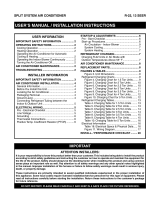
4
in the tubing. If precise forming of refrigerant lines is
required, a copper tubing bender is recommended. Avoid
sharp bends and contact of the refrigerant lines with metal
surfaces.
• Refrigerant tubing should be supported in a manner
that the tubing will not vibrate or abrade during system
operation.
• Tubing should be kept clean of foreign debris during
installation.
• Every effort should be made by the installer to ensure that
the field installed refrigerant containing components of
the system have been installed in accordance with these
instructions and sound installation practices to insure
reliable system operation and longevity.
• The maximum recommended interconnecting refrigerant
line lengths is 75 ft. and the vertical elevation difference
between the indoor and outdoor sections should not
exceed 20 ft.
• A filter dryer is provided with the unit and must be
installed in the liquid line of the system. If the installation
replaces a system with a filter dryer already present in the
liquid line, the filter dryer must be replaced with the one
supplied with the unit. The filter dryer must be installed
in strict accordance with the manufacturer’s installation
instructions.
• Optional equipment such as liquid line solenoid valves,
low ambient, etc., should be installed in strict accordance
with the manufacturer’s installation instructions.
ELECTRICAL WIRING
WARNING:
To avoid risk of electrical shock, personal
injury, or death, disconnect all electrical power
to the unit before performing any maintenance
or service. The unit may have more than one
electrical supply.
Label all wires prior to disconnection when
servicing the unit. Wiring errors can cause
improper and dangerous operation.
• All electrical connections must be in compliance with
all applicable local codes and ordinances, and with
the current revision of the National Electric Code
(ANSI/NFPA 70).
• For Canadian installations the electrical connections
and grounding shall comply with the current Canadian
Electrical Code (CSA C22.1 and/or local codes).
Pre-Electrical Checklist
√ Verify that the voltage, frequency, and phase of the supply
source match the specifications on the unit rating plate.
√ Verify that the service provided by the utility is sufficient
to handle the additional load imposed by this equipment.
Refer to the unit wiring label for proper voltage wiring.
√ Verify factory wiring is in accordance with the unit wiring
diagram. See Figure 2 (page 8). Inspect for loose
connections.
√ Phase balance on 3 phase units must always be checked.
See Unbalanced 3-Phase Supply Voltage section (page
5).
Line Voltage
• A wiring diagram is located on the inside cover of the
electrical box of the outdoor unit. The installer should
become familiar with the wiring diagram before making
any electrical connections to the outdoor unit.
• An electrical disconnect must be located within sight
of and readily accessible to the unit. This switch shall
be capable of electrically de-energizing the outdoor unit.
• Line voltage to the unit should be supplied from a dedicated
branch circuit containing the correct fuse or circuit breaker
for the unit. Incoming field wiring and minimum size of
electrical conductors and circuit protection must be in
compliance with information listed on the outdoor unit
data label. Any other wiring methods must be acceptable
to authority having jurisdiction.
• The outdoor unit requires both power and control circuit
electrical connections. Refer to the wiring diagram /
schematic for identification and location of outdoor unit
field wiring interfaces. See Figure 2 (page 8). Make
all electrical connections in accordance with all applicable
codes and ordinances.
• Overcurrent protection must be provided at the branch
circuit distribution panel and sized as shown on the unit
rating label and according to applicable local codes. See
the unit rating plate for minimum circuit ampacity and
maximum overcurrent protection limits.
• Provide power supply for the unit in accordance with the
unit wiring diagram, and the unit rating plate. Connect
the line-voltage leads to the terminals on the contactor
inside the control compartment.
• Use only copper wire for the line voltage power supply to
this unit in strict accordance of the NEC (ANSI/NFPA 70),
applicable local codes, and the instructions provided with
the equipment. Use proper code agency listed conduit
and a conduit connector for connecting the supply wires
to the unit. Use of rain tight conduit is recommended.
• 208/230 Volt units are shipped from the factory wired for
230 volt operation. For 208V operation, remove the lead
from the transformer terminal marked 240V and connect
it to the terminal marked 208V.
• Optional equipment requiring connection to the power or
control circuits must be wired in strict accordance of the
NEC (ANSI/NFPA 70), applicable local codes, and the
instructions provided with the equipment.
Grounding
WARNING:
The unit cabinet must have an uninterrupted or
unbroken electrical ground to minimize personal
injury if an electrical fault should occur. Do not
use gas piping as an electrical ground
!
This unit must be electrically grounded in accordance with
local codes or, in the absence of local codes, with the National
Electrical Code (ANSI/NFPA 70) or the CSA C22.1 Electrical
Code. Use the grounding lug provided in the control box for
grounding the unit.
Thermostat Connections
• Thermostat connections should be made in accordance
with the instructions supplied with the thermostat and the
indoor equipment.
• The outdoor unit is designed to operate from a 24 VAC
Class II control circuit. The control circuit wiring must












